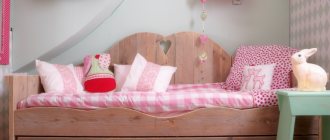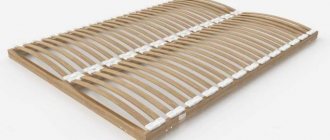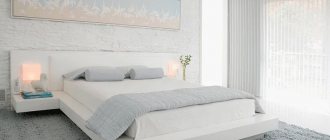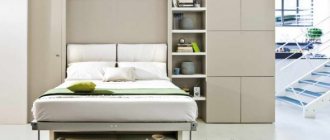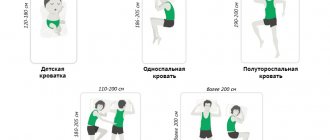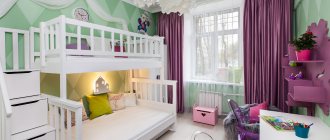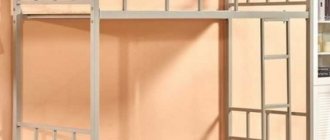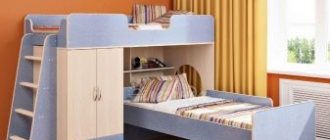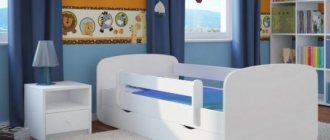Main elements of the bed frame:
- Supports or simply legs can be made of different materials - wood, metal. As a rule, a bed has four legs, but there can also be two – for the width of the frame.
- Backrests – headboard and footboard. There can be two of them or only one - the headboard. Modern beds are mostly equipped with only a headboard. Some types of backrests can be purchased separately and will fit any type of frame.
- The drawers are the side panels of the frame structure. They are fastened together and are the supporting element of the bed. There are drawers that are narrow, the thickness of a mattress, and deep ones that reach the floor.
What types of bed bases are there?
It is customary to distinguish separately types of beds based on their base. Among them are:
- solid - represent a box in which the mattress is placed. The bottom is flat, usually made of plywood or boards. Over time, plywood can sag. In this design, air circulation is difficult, which leads to moisture accumulation in the mattress. Also, it is better not to use solid bases with orthopedic spring mattresses, since it does not provide a springing effect, like a base with lamellas; as a result, the springs are subject to a heavy load and they quickly fail;
- with slats - a modern option that allows the mattress to “breathe” and provides an additional orthopedic effect.
Bed frame height
There are three main bed height standards:
- European;
- Oriental;
- American.
A low oriental bed with a height of 20-40 cm from the floor is perfect for those who like to sleep on the floor. This option is considered more youthful, since it is difficult for an older person to get up from a low sleeping place.
The average height is considered classic - a European bed - 50-60 cm. This bed model is located at knee level.
The American model is very tall and can be 80-100 cm from the floor.
Beds: description and purpose. Variety of models.
- Mattresses
- Beds
- Pillows
- Dream
Introduction
| Selecting a mattress |
| What is the correct mattress or mattress? |
| The history of the mattress from the beginning to the present day. |
Classification
| Types of bed mattresses (classification) |
| Spring mattresses |
| Springless mattresses |
Materials
| Polyurethane foam |
| Memory |
| Natural latex |
| Strutto |
| Thermal felt |
| Sisal |
Orthopedics
| Orthopedic mattresses: definition and varieties |
| Technology for the production of orthopedic mattresses |
Mattresses and human health
| The influence of mattresses on human health |
| Use of mattresses in medicine |
| Magnetic mattresses - a revolution or a fake sensation? |
| Mattresses with massage |
| Mattresses for allergy sufferers |
Selecting a mattress
| How to choose the right mattress |
| Custom or factory made mattresses. What to choose? |
Other
| Mattress care |
| Myths about mattresses |
| Prospects for the development of the mattress market in Russia |
| Round mattresses, advantages and disadvantages |
Beds
| Beds: description and purpose. Variety of models. |
| History of beds |
| Beds with the latest technology |
| Medical beds |
| Materials for making beds |
| Sofa or bed? |
| Bed care |
| Bedroom styles |
| Hammocks. Advantages and disadvantages |
| How to choose the right bed? |
| Zero gravity beds are a requirement for the space age |
| Feng Shui about the placement of beds |
| Folding beds: a modern bed replacement |
| Round beds in the interior of the bedroom |
Pillows
| Pillow: definition, purpose, varieties |
| The path of pillow development - from the Stone Age to modern times |
| Materials for pillows (cases and fillings) |
| Care of pillows, their service life |
| Modern pillows - a symbiosis of traditions and new technologies |
| The shape of the pillow is an important part of a good sleep |
| The influence of pillows on human health and sleep |
| Use of pillows in medicine |
| Choosing pillows: what to look for |
| Pillows for children |
| Hard or soft? |
| Pillowcases are an important bedding item |
| Choosing a pillow for people with allergies |
| Herbal pillows |
Dream
| Sleep hygiene |
| Health and sleep |
| The influence of sleep on learning ability |
| Common misconceptions about sleep |
| Prophetic dreams, where do they come from? |
| The influence of bedding on sleep quality |
| The effect of nutrition on sleep quality |
What is a bed?
A bed is a piece of furniture, usually made of wood or metal and shaped like a rectangle or square. A mattress is installed on the bed frame, matching the shape and size of the bed, and other bedding is also placed.
Origin of the word "bed"
The word bed comes from the ancient Greek κράββατος or the modern Greek κρεββάτι. In the native language, this word means “bed” or “bed.” In addition, as the Etymological Dictionary of the Russian Language notes, the word grabion, meaning hornbeam, has the same root. Thus, it may have originally been a hornbeam bed.
This word came into the Russian language from Greek, obviously due to the close ties between the Russian and Greek Orthodox churches. Perhaps this is due to the Septuagint - the Old Testament of the Bible translated into Greek, carried out in the 2nd-3rd centuries BC. This translation is also known as the translation of the seventy interpreters or the seventy elders. It was from the Septuagint that the word could pass into the Russian language.
It’s hard not to notice that the word “bed” in Russian has a common root with the word “krov”. This may be due to the fact that until recently, houses had a fairly small area and the bed or sleeping area occupied a significant part of them, and were often only slightly smaller than the entire room.
Purpose of the bed
It would seem that the only and most obvious purpose of a bed is to be a place to sleep. A modern person living in a civilized country often sees nothing else in bed. However, the purpose of the bed is much broader. Initially, beds were intended to protect against crawling insects, arthropods, snakes, mice and other living creatures. Structurally, the bed is almost universally a wooden bed on legs. Even in societies that preserve a primitive way of life, lodges often have this form. However, if for us in Russia the threat of being bitten by snakes or scorpions is completely absent, then in countries with a tropical climate this probability is quite high. Even in cities you can encounter snakes or poisonous spiders. That is why many tribes make their beds either high in trees or on high poles instead of legs.
The likelihood of a dangerous animal approaching a person while sleeping is much lower if he is sleeping on a bed than when he is sleeping on the floor or ground.
In addition, in northern latitudes, sleeping on a bed has another advantage. Cold air, having a high density, accumulates in the lower part of the room. Naturally, the higher a person is, the warmer he is. Also, in the lower part of the room, air movement is much more active than at a distance from the floor. Using a bed can reduce the risk of colds.
Bed types
The bed, which was quite primitive in ancient times, has gradually evolved. Today, there are many types of beds that differ in shape, functionality and type of materials used.
The product that most closely resembles the ancient prototype is an ordinary bed with a frame made of wood or metal
, used to install a mattress on it.
Sofa bed
- This is an element of furniture that is intended both for sleeping and for sitting. The sofa is equipped with a special mechanism that allows you to unfold and fold it, locking it in the folded state. As a rule, under the sofa there is a special box for storing bedding.
Chair-bed
is a piece of furniture that, when folded, can be used as an armchair, and when unfolded, can be used as a single bed. As in the case of a sofa bed, such a chair can significantly save space in small apartments or organize a guest sleeping place with minimal use of the apartment’s usable area.
Bunk bed
- another way to optimize the space of the apartment. This design consists of two beds placed one above the other. Today they are used either for organizing temporary residence of a large number of people in common rooms (barracks, living quarters for shift workers, etc.), or for arranging children's rooms.
Cot
– lightweight folding bed. Usually used as a guest bed or for sleeping for a short time, for example, in the country. Today there are quite a few types of folding beds, some of them can even be equipped with orthopedic mattresses.
Hammock
- one of the most ancient types of beds. It was originally made from intertwined vines secured between two trees. Today, hammocks are made from durable natural, synthetic or combined ropes. Hammocks are very comfortable, but you can only sleep on them while lying on your back.
Ottoman
– a wide bed with no more than one backrest. The ottoman is hard, so to rest on it you need to lay a soft mattress or blanket. It is used primarily for daytime recreation and is widespread in Asian countries.
Topchan
– a single bed intended for relaxation. Most often they are installed on beaches, near pools or on lawns. They are made of plastic or wood and have a rising head. It can have either a fabric, wooden or plastic bed. In the last two cases, special mattresses made of foam rubber or some other materials are placed on them.
Bunks
- plank flooring intended for sleeping. This is one of the most primitive types of beds, which can only be used in conjunction with mattresses. One long edge of the bunk is attached to the wall at a height of several tens of centimeters from the floor. In Russia, bunks are used primarily in places of detention.
Inclined bed
. This type of bed has a medical purpose and is intended for the treatment of people suffering from severe snoring. Such people constantly wake up while snoring. In fact, they hardly sleep deeply. Therefore, in the morning they feel tired and sleep-deprived. An inclined bed can reduce snoring or eliminate it completely, allowing people to lead a fulfilling lifestyle. In addition, snoring often keeps the entire family, and in some cases even housemates, awake.
Bed for certain types of patients
. A distinctive feature of such a bed is the presence of a mechanism that allows you to lower and raise the bed, as well as separately tilt the part of the bed located under the patient’s head and back or under his feet. This makes it possible to establish high-quality bedside care for postoperative patients and some other patients.
Raising bed
can rise to a vertical position. Great for small spaces. Its properties are no different from ordinary beds and provide a high level of comfort.
The headboards of modern beds are often carved or otherwise decorated.
Bed sizes
Common bed sizes in Europe are 0.9 x 2m for a single bed, 1.4 x 2m for a double, 1.6 x 2m for a king and 1.8 x 2 for a super king. It should be remembered that 0.9 m is the minimum permissible bed width per person.
Bed support
Typically, standard beds rest on four legs, but there are models with a fifth leg in the center. It is installed for greater stability. For such a bed, the headboard and footboard may be absent or hung on the frame frame.
There are also beds that rest on the foot and back at the same time. In this model, the side panels perform only a decorative function.
In modern furniture stores you can find hanging beds, the head of which is attached to the wall, and a leg is attached in the center for stability.
Criterias of choice
When choosing accessories for assembling a bed, pay attention to the reputation of the manufacturer. Thanks to the reliability of the brand, the likelihood of unnecessary costs of finance and time is significantly reduced, since the risk of failure of low-quality fasteners, and, accordingly, the need to purchase a new one, is minimized. Fasteners from a reliable manufacturer compare favorably with cheap analogues by a certain set of advantages:
- long operational period;
- large assortment range;
- high quality performance;
- strength;
- practicality;
- functionality.
A responsible manufacturer takes into account the needs of users, ensures the selection of the right products, and monitors the quality of its own products. Unfortunately, these advantages are lacking in accessories from China, with which the market is oversaturated. Most of these products have not been certified and are not of high quality.
Using the listed criteria, you can choose high-quality fittings. The fastening of parts made using such elements will be reliable and durable. This will ensure a presentable appearance of the furniture - the bed will last a long time without loss of performance characteristics.
Fasteners from a reliable manufacturer have a longer service life compared to cheap analogues
Chinese fittings, as a rule, are not of high quality and do not have the necessary certificates
Practical and functional fittings will ensure the furniture looks presentable for a long time
Bed frame type
There are two main types of frames:
- Futon frame
- Frame-pocket
The design of the futon frame is very similar to a wooden podium on which the mattress lies. But, if you toss and turn a lot in your sleep, the mattress will constantly slide down. The advantage of such a frame is that you can do without mattress bars.
A more common option is the pocket frame. In this case, the mattress is placed in restraints that prevent it from slipping.
Model classification
Long gone are the days when only kings and owners of medieval castles enjoyed the privilege of sleeping on a bed, and ordinary people huddled on straw mattresses. Today it is difficult to imagine the life of a modern person without a full-fledged sleeping place in the house. Over several centuries of existence, so many different types of beds have appeared that there is even a need to classify them.
By purpose and dimensions
All beds, according to their purpose, are divided into age categories, which differ in size. Adults are classified according to the number of sleeping places:
- Single. Size - from 80 to 120 cm in width, depending on the model. The length varies between 190 and 210 cm.
- One and a half. Its width is slightly larger than a single bed and is 120–160 cm.
- Double. The design ranges in size from 160 to 230 cm wide and 200–220 cm long.
Single
One and a half
Double
Children's models depend on the age of the child:
- The very first crib in a baby’s life is a cradle. This model is used for up to six months, then the baby grows out of it. The width of the cradle is less than 60 cm, and the length does not reach one meter.
- A crib with lattice sides measuring 60 x 120 cm is suitable for children from six months to two years. The side walls should not be higher than 95 cm, the bed is located at a height of 30 to 50 cm.
- For a preschool child, from two to six years old, a loft bed is suitable. The standard design is complemented by a sports or play area. The size of the bed is 60 × 140 cm.
- A single model measuring 80 × 200 cm is suitable for a schoolchild aged 6–13 years.
- A sleeping bed for a teenager can be from 90 to 160 cm wide. Length is 180–200 cm.
Beds made in Europe (Greece, Italy, Germany) are 5 cm longer and wider than Russian standards.
Cradle
Cot-playpen
For a child from 3 years old
For younger students
For a teenager
By functionality
Bed designs have undergone some changes since their first production and have become more functional. Models have appeared with compartments for storing linen; the bed is often equipped with a lifting mechanism. All beds can be divided into three types. The first is classic models that are not equipped with storage space. The second are beds with drawers or drawers. The design is convenient; to access things you don’t have to lift the bed every time. The third are models in which the storage box is located inside under the mattress. To access things you have to lift the bed, so it is often equipped with a lifting mechanism. Furniture not very convenient for regular use.
No storage space
With drawers
With lifting mechanism
By type of base
Manufacturers use the following types of structures for the base:
- Solid bottom. Made from a single sheet of plywood, chipboard, MDF. Beds with such a base are inexpensive. Among the disadvantages is the inability to withstand heavy loads. Such furniture will not last long and will quickly fail.
- The bottom is made of wooden planks - lamellas. This design is valued because, with sufficient rigidity, it is characterized by plasticity and has an orthopedic effect. It is important to pay attention to the number of lamellas and the distance between them. The more slats and the smaller the spacing, the higher the weight the bed will support and the longer its lifespan.
Characteristics of beds with drawers, manufacturing and assembly features.
There is also a lattice base made of a frame to which bent-glued or metal slats are attached. This design has good ventilation, increased strength, and provides comfortable rest.
Solid bottom
Wooden slats
Materials depending on price category
Different materials are used to make beds. Each of them has its own advantages and disadvantages. Products differ in cost, service life, and appearance.
Interior beds made of solid wood surprise with their variety of designs. They look expensive and solid. Such products are durable, environmentally friendly, and characterized by high strength. Noble types of wood are used in production, such as oak, birch, beech, and mahogany. Each breed has its own unique pattern, shade and aroma. A bed made of solid wood will not creak or become loose even under high loads. Carving, decoupage, rhinestones, and artificial aging are often used for decoration. Such beds are considered elite and are expensive. Among wooden furniture, designer furniture is most often found.
For lovers of natural materials who want to save money, beds are made from pine. It is softer than noble types of wood, but also looks rich and elegant. But it is worth remembering that an impact can cause unevenness on such a bed, so it should be handled with care. With careful use, pine furniture will last a long time. Due to their affordable price, such beds are in high demand.
Wood panels are used in the production of economy class furniture. They successfully replace the array, although they differ in a number of disadvantages.
- Chipboard is natural wood shavings pressed with glue. Furniture made of this material, when exposed to heat or moisture, begins to release harmful substances into the atmosphere, which is unsafe for health. But products made from this raw material are distinguished by a wide variety, they are easy to care for, and are equal in strength to pine.
- Laminated chipboard is a wood board covered with veneer, plastic or laminated film. The surface repeats the pattern of natural wood. The material is highly durable and is not susceptible to chips and scratches. The structure of the slab does not allow the manufacture of products with decoration. Usually these are smooth shapes and angles, without curves or patterns.
- MDF is a material made from pressed small wood. The surface allows you to apply a pattern, imitate carvings and make rounded corners. Products made from MDF have good moisture resistance, can easily withstand high temperatures, and are not susceptible to the formation of mold and mildew.
Metal beds deserve special attention. Modern models have come a long way from their bulky ancestors with armored pressed mesh. Today these are stylish, comfortable products that have advantages even over beds made of natural wood. The metal has high strength and reliability. The beds are made from hollow tubes, so they are light in weight and the furniture is easy to transport. Such models are distinguished by a rich choice of finishes - forging, carving, various decorative elements. A metal bed always looks thin and elegant, and the middle price segment ensures high consumer demand for it.
How to choose the right corner bed for children and adults
Solid wood
laminated chipboard
MDF
Metal
